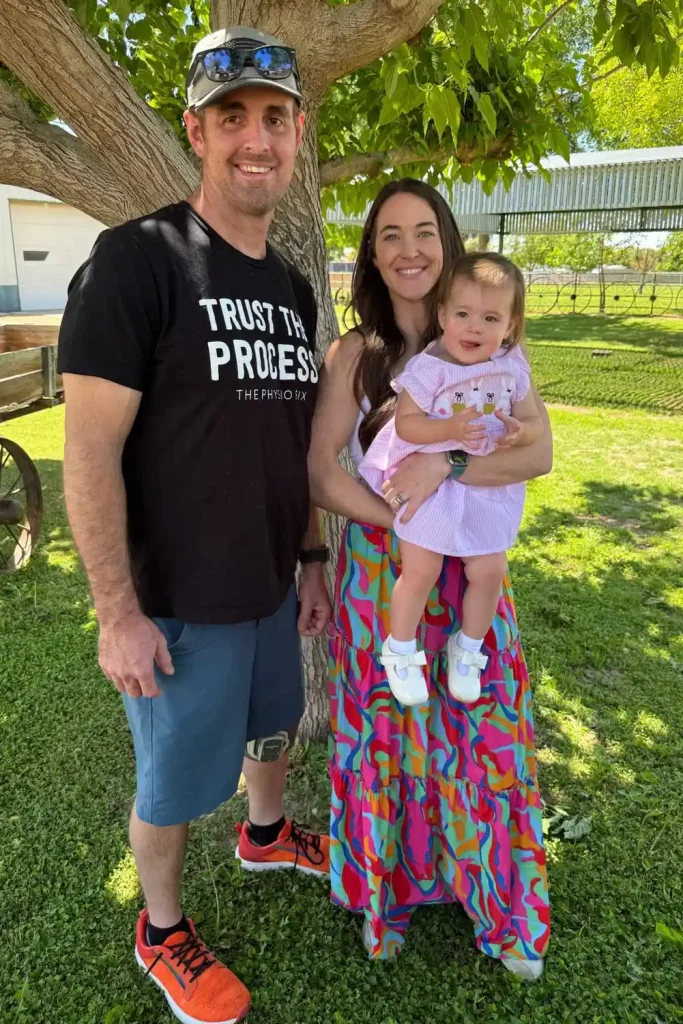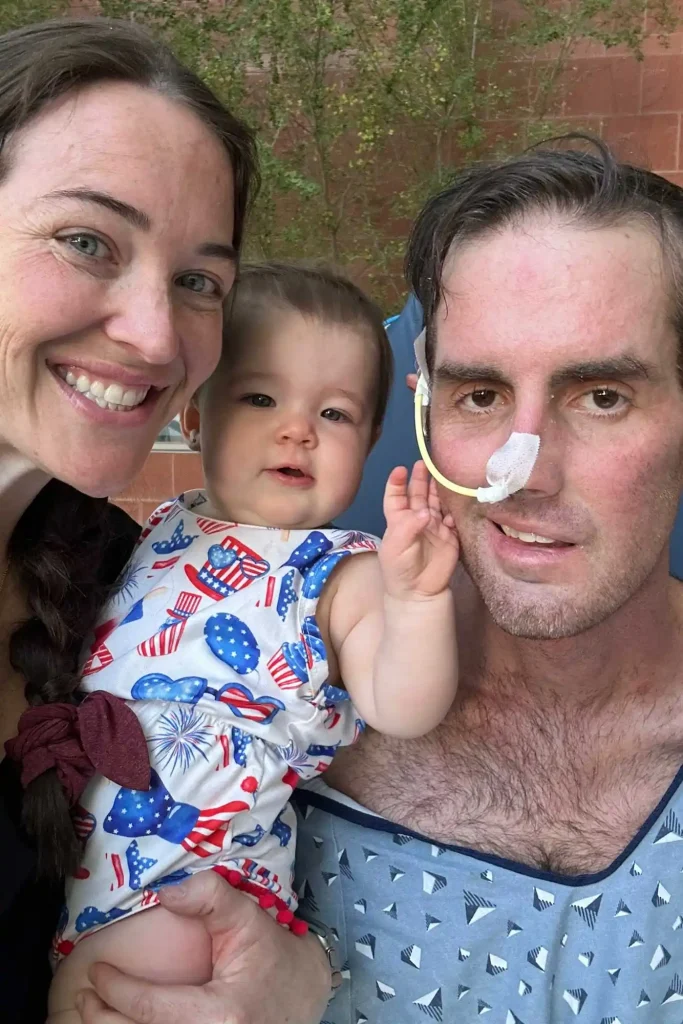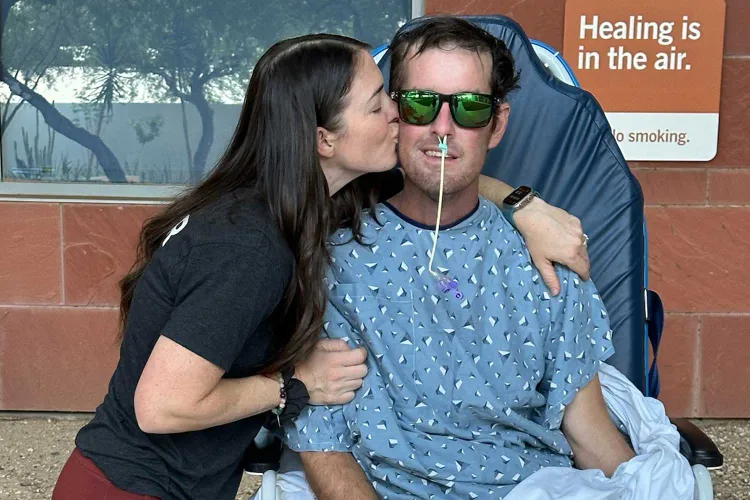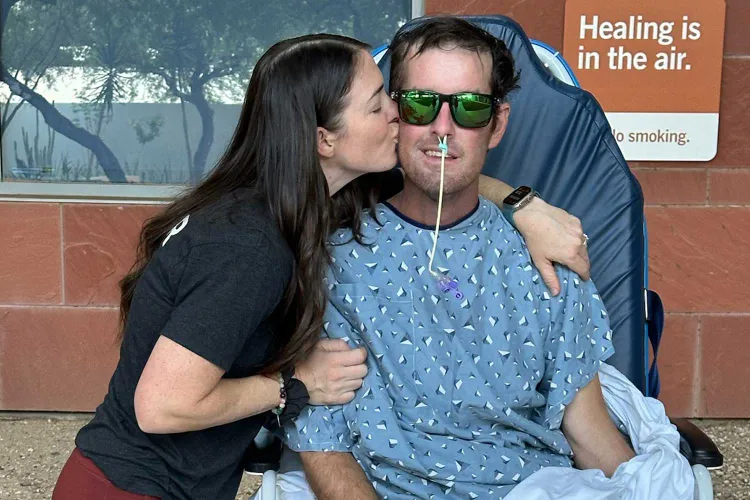Doctors Said He Wouldn’t Survive — But His Wife’s Relentless Rehab Plan Helped a 37-Year-Old New Dad Walk Again and Reclaim His Life
When Logan Barber collapsed last September, nothing about his life suggested tragedy was near. At 37, he was strong, active, and newly adjusting to life as a first-time father. His days were full — a thriving job, long hours, time in the gym, and nights spent rocking his baby daughter to sleep beside his wife, Stacie. But one morning in September 2024, everything changed. A sudden, catastrophic stroke struck without warning, leaving Logan clinging to life and his family facing a nightmare that no one could have predicted.

The diagnosis was severe — a major hemorrhagic stroke that caused widespread brain damage. Doctors warned Stacie that survival was unlikely, and even if he did pull through, he would probably never walk or talk again. For most people, that would have been the end of the story. But for Stacie Barber, a physical therapist and founder of her own Phoenix-based practice, The Physio Fix, it was the start of a fight she refused to lose.

“I remember standing there as they told me he might not make it,” Stacie recalled later. “But all I could think was — we are not done. I wasn’t ready to say goodbye.”
As a trained clinician, Stacie understood the odds. As a wife and new mother, she didn’t care. She turned their hospital room into a mission space. While monitors beeped and ventilators hummed, she began using her professional skills to design a recovery plan that most would have thought impossible.

Logan spent weeks in the ICU, his body almost completely unresponsive. He couldn’t walk, talk, or swallow. He was fed through tubes. Doctors advised patience but gently reminded her that full recovery wasn’t realistic. Stacie, however, began therapy immediately — before formal rehabilitation even started. She used gentle tactile cues to stimulate Logan’s muscles, music therapy to reawaken brain activity, and vibration and resistance exercises she’d refined in her clinic.

She documented every sign of life — a flicker of a finger, a faint movement of his toes — and celebrated them as victories. “When everyone else was saying, ‘Wait,’ I just couldn’t,” she said. “I’ve spent my life helping people recover. There was no way I was going to stand by and do nothing for my own husband.”
Her determination quickly caught the attention of the medical team. Nurses and therapists began working in tandem with her, following her lead as she implemented unconventional methods tailored to Logan’s background as a powerlifter and athlete. The man who once deadlifted more than 700 pounds now struggled to move his arm — but Stacie knew how to rebuild him. “The process is the same,” she explained. “You strengthen what you can, stimulate what’s asleep, and you never give up on progress.”
After four long weeks in the ICU, Logan opened his eyes and began to respond. It was the beginning of what would become one of the most inspiring recoveries his medical team had ever seen. When he finally left the hospital, he did so in a wheelchair, still weak and partially paralyzed — but alive, determined, and ready to start again.

Back home, the Barbers turned their living space into a full-scale rehabilitation center. Ramps were built, doorways widened, and every day became a structured schedule of therapy. Stacie incorporated every technique she knew: mobility drills, neural retraining, balance practice, and assisted walking. Their toddler often sat nearby, clapping each time her father managed to move a little more.
There were setbacks — days when his speech faltered, or his balance failed, or fatigue seemed to erase progress. But Stacie refused to accept despair. She often reminded Logan of his old strength, showing him photos from his gym days as motivation. “She was relentless,” Logan later said. “When I didn’t believe in myself, she did enough for both of us.”
Months passed, and progress followed. The man once told he would never walk again began taking steps with a walker. His speech improved, his coordination sharpened, and his personality — that mix of humor and determination — started to return. For Stacie, it was validation of both love and science. “We don’t always realize how much the human body can heal when the heart and mind are all in,” she said.
By spring 2025, Logan had achieved what doctors once called impossible. He walked into a follow-up appointment using only a brace for balance. Later, he returned to his home gym for the first time — lifting light weights, working carefully, and smiling through tears. “That was the moment,” he said. “The day I knew I was going to live my life again.”
Today, Logan continues to rebuild his strength. He still experiences mild challenges, including partial foot drop and fatigue, but he’s walking, driving, working full-time, and playing with his daughter. For the Barbers, the journey has transformed how they view recovery, resilience, and love. “The hardest part wasn’t the therapy,” Stacie said. “It was learning patience — giving yourself grace through every setback.”
Their story has resonated far beyond Phoenix. Through The Physio Fix’s social media and outreach, Stacie has shared updates and motivational insights for other families facing medical crises. She emphasizes early movement, proactive care, and the power of informed advocacy. “You can’t just wait for hope,” she explained. “You have to create it — every single day.”
Medical experts who reviewed Logan’s case have credited several factors for his extraordinary recovery: his high level of pre-stroke fitness, his wife’s expertise, and her immediate intervention. But even with these advantages, his progress remains extraordinary. His doctors have described him as “a rare case of full functional recovery from a near-fatal hemorrhage,” calling his progress “nothing short of phenomenal.”
Beyond the clinical success, though, the heart of the story lies in the couple’s devotion. Married for years, now parents navigating both parenthood and rehabilitation, they’ve turned what could have been a tragedy into a testament to partnership. “There were nights I cried in the bathroom,” Stacie admitted. “I was scared, angry, exhausted. But every morning, I looked at him and said, ‘We’re still doing this.’”
As the months passed, their focus shifted from mere survival to celebration. They began marking each milestone with family walks, community events, and shared posts designed to spread awareness about stroke prevention in young adults. “We never imagined we’d be advocates,” Logan said. “But if one family reads our story and refuses to give up, it’s worth it.”
Their journey also underscores a growing issue in public health: the rising number of strokes among younger adults. According to data from the CDC, roughly 10–15% of strokes occur in people under 50. Lifestyle, genetics, and stress are contributing factors, and early recognition can save lives. For Stacie, the experience has made her mission personal. “If sharing our story makes one person go to the ER sooner, it’s a win,” she said.
Today, Logan’s recovery continues. He spends mornings at work, afternoons with his daughter, and evenings training with modified routines. His speech is strong, his sense of humor sharper than ever. “I know what it’s like to lose everything,” he said recently. “Now, every moment feels like a bonus round.”
For Stacie, watching him stand, walk, and hold their daughter has been the greatest reward. “People say it’s a miracle,” she reflected, smiling. “But miracles don’t just happen. They’re built — through love, work, and the refusal to give up.”
Their story has become a beacon of hope for countless families facing similar odds — a reminder that even in the darkest chapters, strength can come from unexpected places. It’s the story of a man who fought his way back and the woman who never stopped fighting for him. Together, they turned an ending into a beginning — and showed the world what’s possible when love refuses to surrender.


